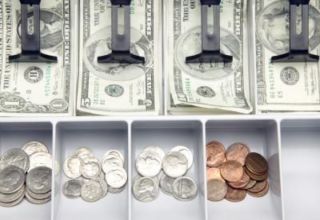1- Place a standard amount of cash in the drawer at the beginning of each work day. Set it at the lowest amount that seems feasible to be able to make change for customers. If your business accepts credit and debit cards, you might be able to set this amount fairly low, since many people will likely choose to pay via those methods. If your business is cash-only, you might need to set the beginning cash amount rather high.
2- Make a single cashier accountable for a single cash drawer at a time. If there are multiple people using the same cash drawer at the same time, it will be more difficult to track any potential problems.
3- Count the cash drawer at the beginning of each shift to verify amounts. Print out cash drawer reconciliation slips or keep a notebook where you and your employees can log this information.

4- Keep credit card receipts separate from cash receipts. This will make it easier to tally both kinds and make a full report of all receipts at the end of the business day.
5- Count cash in a secluded area, away from the eyes of customers. Tabulate the amount of cash in the drawer, including all coins. If your business accepts checks, these should be counted as well. Log all these amounts. Next, count up the amounts the various receipts say should be there. Make sure they match how much money is actually there. If your business uses a point-of-sale computer software system, it should have these figures easily available for you as well.
Tips & Warnings
Balance cash drawers at the end of each shift, not just at the end of each day. Before you or any other employee clocks out, all receipts should be tallied and cash in the drawer counted. Any discrepancies should be noted and reported to management as well. Log all this information on your cash drawer reconciliation slip or notebook for that day.
Make sure to account for any sales that were voided over the course of the day. For instance, if the cashier rang up an item and the customer decided not to buy it, it would have been voided and returned to the sales floor. However, the item will still have made an impact on your cash register. Hopefully, the cashier on duty at the time will have voided it, but this is a good place to check if there are otherwise unexplained discrepancies.
2- Make a single cashier accountable for a single cash drawer at a time. If there are multiple people using the same cash drawer at the same time, it will be more difficult to track any potential problems.
3- Count the cash drawer at the beginning of each shift to verify amounts. Print out cash drawer reconciliation slips or keep a notebook where you and your employees can log this information.

4- Keep credit card receipts separate from cash receipts. This will make it easier to tally both kinds and make a full report of all receipts at the end of the business day.
5- Count cash in a secluded area, away from the eyes of customers. Tabulate the amount of cash in the drawer, including all coins. If your business accepts checks, these should be counted as well. Log all these amounts. Next, count up the amounts the various receipts say should be there. Make sure they match how much money is actually there. If your business uses a point-of-sale computer software system, it should have these figures easily available for you as well.
Tips & Warnings
Balance cash drawers at the end of each shift, not just at the end of each day. Before you or any other employee clocks out, all receipts should be tallied and cash in the drawer counted. Any discrepancies should be noted and reported to management as well. Log all this information on your cash drawer reconciliation slip or notebook for that day.
Make sure to account for any sales that were voided over the course of the day. For instance, if the cashier rang up an item and the customer decided not to buy it, it would have been voided and returned to the sales floor. However, the item will still have made an impact on your cash register. Hopefully, the cashier on duty at the time will have voided it, but this is a good place to check if there are otherwise unexplained discrepancies.
How to Reconcile a Cash Drawer
4/
5
Oleh
samy






